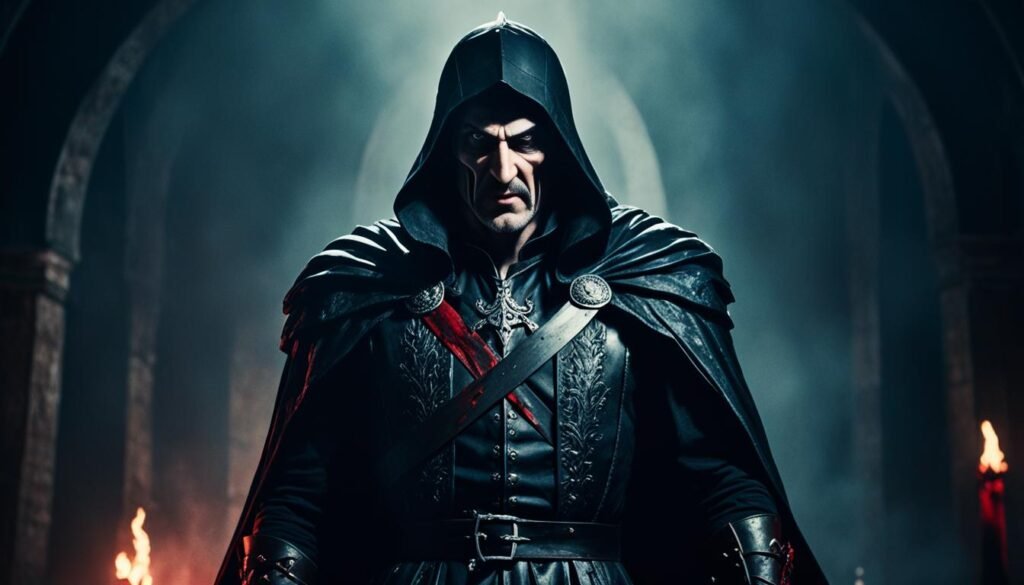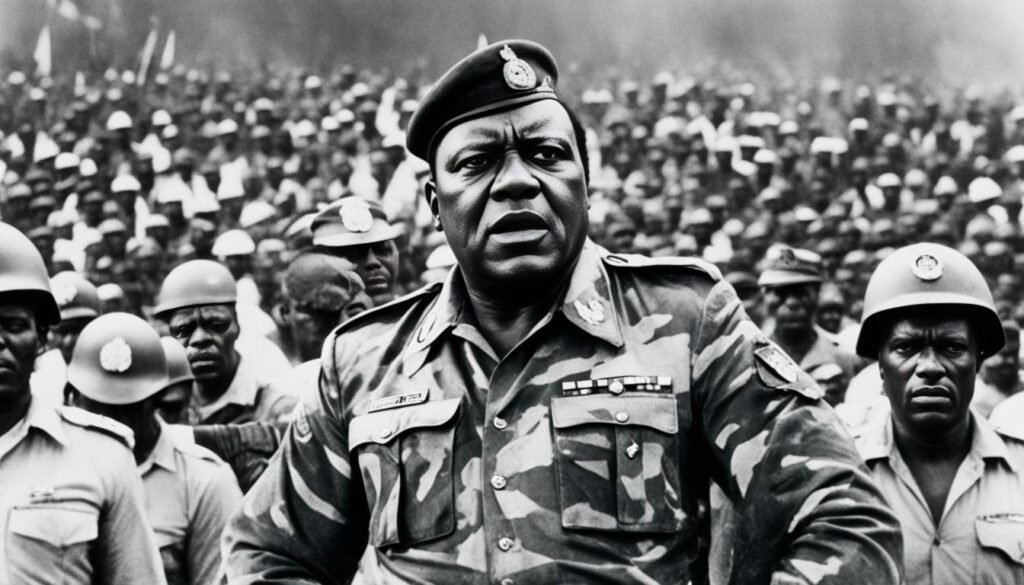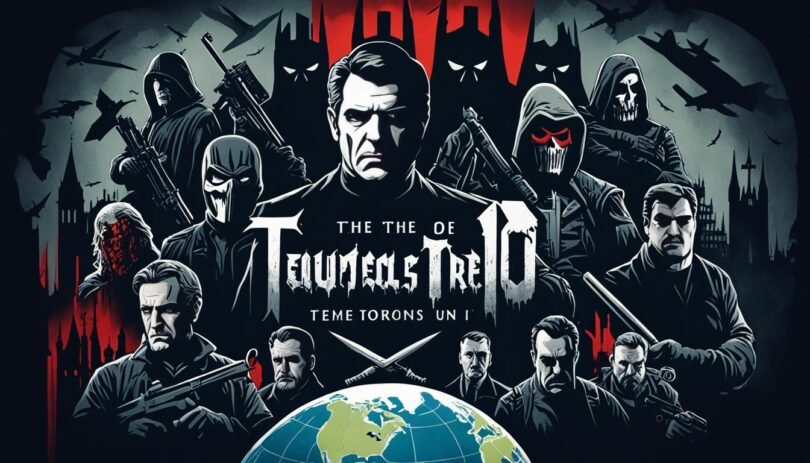Throughout history, humanity has witnessed the rise of ruthless leaders who have inflicted immense suffering upon their fellow beings. These men, driven by dark desires, have left a trail of devastation and cruelty that continues to haunt us to this day. But who are these individuals? What were their motivations? And what did their reigns of terror truly entail?
Prepare to be shocked as we unveil the top 10 most cruel men on Earth. Brace yourself for an exploration of their sadistic actions, their thirst for power, and the horrifying impact they had on countless lives. From dictators to serial killers, their stories will both fascinate and chill you to the core.
Are you ready to delve into the darkest depths of human history? Join us on this journey to discover the chilling truth behind these notorious figures. Unlock the secrets of their tyranny and witness the unimaginable horrors they unleashed upon the world.
Key Takeaways:
- Explore the lives of history’s most cruel men and learn about their brutal reigns.
- Uncover the motivations and sadistic tendencies that drove these individuals.
- Understand the lasting impact of their actions on society and humanity as a whole.
- Reflect on the nature of power, cruelty, and the depths of human depravity.
- Challenge your preconceived notions about the capacity for evil within our species.
Unraveling the Darkness: History’s Ruthless Leaders
Throughout history, humanity has been plagued by the darkness that resides within some individuals. These ruthless leaders have left an indelible mark on society, leaving behind trails of devastation and suffering. By examining the lives and actions of these tyrants, we can begin to unravel the complex web of darkness that permeates our past.
In our quest for understanding and knowledge, it is crucial to confront the horrors that ruthless leaders have wrought upon the world. By shining a light on their atrocities, we can ensure that history does not repeat itself and that the lessons learned from their reigns of terror stay etched in our collective memory.
From Adolf Hitler’s brutal regime and the Holocaust to Joseph Stalin’s iron fist over the Soviet Union, these leaders exemplify the depths of human cruelty and the immense power they wielded over their subjects. Their actions serve as a stark reminder of the darkness that can reside within even the most charismatic and influential figures.
“The only thing necessary for the triumph of evil is for good men to do nothing.” – Edmund Burke
By uncovering the truth and shining a light on these ruthless leaders, we can honor the victims and ensure that their sacrifice is not in vain. It is through the study of history that we gain a deeper understanding of the darkest aspects of humanity and can strive to create a better future.
- Adolf Hitler: The Genesis of Hitler’s Tyranny
- Joseph Stalin: The Iron Fist Over the Soviet Union
- Vlad the Impaler: Wallachia’s Reign of Terror
- Pol Pot: The Terrifying Rule of Cambodia
- Heinrich Himmler and the SS: Architects of the Final Solution
- Saddam Hussein’s Legacy of Brutality in Iraq
- Idi Amin: The Butcher of Uganda’s Reign of Terror
- Ivan the Terrible: The First Tsar’s Brutal Rule
- Leopold II: The Congo Free State Atrocities
As we navigate through the stories of history’s ruthless leaders, let us remember the importance of confronting the darkness that exists within our world. By acknowledging the past, we can work towards a future where cruelty and tyranny are nothing more than distant memories.
The Harsh Reign of Adolf Hitler and the Holocaust
Adolf Hitler, the infamous German dictator, is remembered as one of history’s most brutal and tyrannical leaders. His reign of terror during World War II left an indelible mark on humanity, forever associated with the Holocaust and the atrocities committed during that dark period.
The Genesis of Hitler’s Tyranny
Adolf Hitler rose to power in Germany in the 1930s, fueled by his fervent nationalism and antisemitic beliefs. He exploited the economic hardships and social unrest of the time, harnessing the discontent of the German people to consolidate his power.
Using propaganda and discriminatory policies, Hitler and his Nazi Party established a totalitarian regime that suppressed opposition, controlled the media, and encroached upon civil liberties. This marked the beginning of his tyrannical rule, which would ultimately lead to the horrors of the Holocaust.
The Holocaust: An Unprecedented Genocide
The Holocaust, often referred to as the “Shoah,” stands as one of the darkest chapters in human history. Under Hitler’s command, an estimated six million Jews, along with millions of other minority groups, were systematically persecuted and murdered.
The Hitler regime implemented an elaborate network of concentration camps, death camps, and ghettos where innocent men, women, and children were subjected to unimaginable brutality. The methods employed included mass shootings, gassings, forced labor, starvation, and medical experiments.
The scale and savagery of the Holocaust were unprecedented, leaving a scar on the collective memory of humanity. The systematic destruction of an entire race was carried out with chilling efficiency, fuelled by Hitler’s ideology of racial superiority and a cruel disregard for human life.
The Final Days of the Führer
As Allied forces closed in on Germany towards the end of World War II, Hitler’s reign of terror approached its devastating conclusion. Rather than face justice, he chose to take his own life in his bunker in Berlin on April 30, 1945.
With Hitler’s death, the barbaric regime he had built crumbled, but the scars of his tyranny and the Holocaust remain. The world was forced to confront the horrifying consequences of unchecked hatred and oppression, vowing to never forget the victims and to strive towards a future devoid of such atrocities.
| Key Takeaways: |
|---|
| Adolf Hitler’s reign was characterized by brutal tyranny and the implementation of the Holocaust. |
| His rise to power was facilitated by the economic and social unrest in Germany during the 1930s. |
| The Holocaust was a systematic genocide that saw the murder of six million Jews and millions of other minorities. |
| Hitler’s ideology of racial superiority and his disregard for human life fueled the unprecedented scale of the Holocaust. |
| Hitler’s reign of terror came to an end with his own suicide in his bunker in Berlin. |
Joseph Stalin’s Iron Fist Over the Soviet Union
Joseph Stalin, one of history’s most notorious figures, ruled the Soviet Union with an oppressive and tyrannical grip. His regime was marked by mass repressions, purges, and the loss of millions of lives.
Under Stalin’s rule, the Soviet Union experienced a period of intense political repression known as the Great Purge. In this ruthless campaign, Stalin targeted perceived enemies of the state, including political rivals, intellectuals, and ordinary citizens. Joseph Stalin used various tactics to suppress dissent, including arbitrary arrests, forced confessions, and executions.
The impact of Stalin’s iron fist was devastating. Countless lives were lost to his regime’s brutality, as people were sent to labor camps, imprisoned, or summarily executed. The scale of these atrocities is difficult to comprehend, as families were torn apart and communities were decimated.
Stalin’s rule also saw the implementation of collectivization and forced industrialization, which caused immense suffering among the Soviet population. Peasants were forcefully relocated from their land, leading to famine and widespread hardship.
Despite the harsh realities of Stalin’s reign, his legacy remains controversial. Some view him as a strong leader who transformed the Soviet Union into a major global power, while others condemn him for his ruthless methods and disregard for human life.
Regardless of one’s perspective, Joseph Stalin’s iron fist over the Soviet Union continues to serve as a stark reminder of the devastating consequences that can result from unchecked power and authoritarian rule.
Vlad the Impaler: The Real-Life Dracula
Vlad the Impaler, also known as Vlad III or Vlad Dracula, is infamous for his sadistic reign of terror in Wallachia, a region in present-day Romania. His brutal methods and sadistic pleasures have earned him a place in history as one of the most feared and ruthless rulers.
Wallachia’s Reign of Terror
Vlad the Impaler ruled Wallachia in the 15th century, during a time of political turmoil and constant threat from the Ottoman Empire. To maintain control and instill fear in his subjects, Vlad resorted to extreme and sadistic measures. He perfected the art of impalement, a method in which victims were brutally skewered and left to die a slow and agonizing death. The sight of impaled bodies served as a horrifying deterrent for any potential adversaries.
In addition to impalement, Vlad employed other cruel tactics to maintain his reign of terror. He was known to burn villages, torture prisoners, and even feast among his dying victims. His sadistic nature knew no bounds, and he reveled in the suffering of others.
The Sadistic Pleasures of Vlad
Vlad the Impaler’s sadistic tendencies were not limited to public displays of cruelty. He took pleasure in personally torturing and mutilating his victims, often deriving satisfaction from their pain and suffering. It is said that he enjoyed drinking the blood of his enemies, earning him the nickname “Dracula,” meaning “son of the dragon.”
“I have never allowed myself to be influenced in any way by sadistic pleasure or to indulge in cruelty, but I have always had a passion for justice and the salvation of the people, who, so often oppressed, require a strong and vigilant ruler.” – Vlad the Impaler
Vlad’s sadistic nature extended to his rule as well. He implemented strict laws and harsh punishments, ensuring that any disobedience or dissent would be met with the utmost cruelty. His brutal methods left a lasting impact on Wallachia, forever cementing his reputation as a sadistic ruler.

| Methods of Cruelty | Impact on Wallachia |
|---|---|
| Impalement | Terrified the population and deterred potential enemies |
| Burning villages | Destroyed communities and instilled fear |
| Torture and mutilation | Caused extreme suffering and demonstrated Vlad’s sadistic nature |
| Feasting among dying victims | Display of power and disregard for human life |
The Terrifying Rule of Pol Pot in Cambodia
Pol Pot, the infamous dictator, was responsible for one of the most brutal and devastating reigns of terror in modern history. His rule in Cambodia during the 1970s resulted in the mass genocide of millions of innocent people and left a lasting impact on the country.
Under Pol Pot’s regime, known as the Khmer Rouge, Cambodia was plunged into darkness. Pol Pot implemented radical communist policies that aimed to transform Cambodia into an agrarian society. As part of this vision, he forcibly relocated urban dwellers to rural areas, abolished currency, abolished religion, and dismantled the education and healthcare systems.
One of the most horrifying aspects of Pol Pot’s rule was the widespread use of torture, forced labor, and executions. Intellectuals, professionals, and anyone perceived as a threat to the regime were targeted and systematically eliminated. The infamous Tuol Sleng prison, also known as S-21, was a place of unimaginable suffering and death.
The genocide orchestrated by Pol Pot and his followers was aimed at creating a pure agrarian society, free from any elements deemed “impure” or “corrupt.” It is estimated that up to 2 million people, approximately one-quarter of Cambodia’s population, lost their lives during this dark period.
The aftermath of Pol Pot’s brutal rule is still being felt in Cambodia today. The country struggles to heal and rebuild from the trauma inflicted upon its people. The scars left by Pol Pot’s atrocities serve as a haunting reminder of the depths of human cruelty and the importance of safeguarding human rights.
Despite his downfall in 1979, Pol Pot’s legacy continues to haunt Cambodia and the world. His reign of terror stands as a stark reminder of the atrocities that can be committed under the guise of ideology, and the importance of remaining vigilant against such tyranny.
Heinrich Himmler and the SS: Architects of the Final Solution
Heinrich Himmler and the SS played a central role in one of the darkest chapters in human history, the Holocaust. As the head of the SS (Schutzstaffel), Himmler was responsible for implementing the Final Solution, the Nazi plan for the systematic extermination of millions of Jews during World War II.
Under Himmler’s leadership, the SS grew to become a powerful paramilitary organization, exerting control over the concentration camps and the entire Nazi apparatus of terror. Himmler played a key role in planning and overseeing the construction of extermination camps, such as Auschwitz, Treblinka, and Sobibor, where millions of innocent lives were brutally extinguished.
“We must be honest, decent, loyal, and comradely to members of our own blood and to nobody else. What happens to the Russians or the Czechs is a matter of utter indifference to me.” – Heinrich Himmler
Himmler’s fanatical loyalty to Adolf Hitler and his commitment to the Nazi ideology of racial purity fueled the implementation and escalation of the Final Solution. The SS, under his command, played a fundamental role in coordinating the logistics of mass extermination, including the deportation, forced labor, and eventual execution of millions of Jews.
This meticulously planned and ruthlessly executed plan aimed to eradicate European Jewry and other targeted groups in pursuit of a racist utopia envisioned by Hitler and the Nazi regime. The SS oversaw the systematic murder of men, women, and children, employing gas chambers, mass shootings, and other inhumane methods to carry out their genocidal mission.
Heinrich Himmler and the SS exemplify the epitome of human cruelty, their actions staining history with unimaginable suffering. The legacy of their crimes and the horrors of the Final Solution serve as a stark reminder of the depths of depravity that humanity is capable of descending into when fueled by hate and prejudice.
Saddam Hussein’s Legacy of Brutality in Iraq
Saddam Hussein, the former President of Iraq from 1979 to 2003, is remembered for his brutal reign and the lasting impact it had on the nation. His regime was marked by widespread violence, repression, and fear, leaving behind a legacy of brutality that still haunts Iraq to this day.
Chemical Attacks and Institutionalized Torture
One of the most notorious aspects of Saddam Hussein’s rule was his use of chemical attacks against both internal and external enemies. In the 1980s, he ordered the gassing of Kurdish civilians in the town of Halabja, resulting in the deaths of thousands of innocent men, women, and children. This heinous act of cruelty highlighted Saddam’s willingness to employ any means necessary to maintain his grip on power.
In addition to chemical warfare, Hussein’s regime was also known for its systematic use of torture. Political dissidents, suspected enemies of the state, and anyone perceived as a threat were subjected to brutal interrogations, including methods such as beatings, electric shocks, and sexual violence. These acts of torture were widespread and carried out by specialized units within the regime’s security apparatus.
The Gruesome Spectacle of Saddam’s Repression
Under Saddam Hussein’s rule, Iraq became a place of immense repression and fear. The population lived in constant uncertainty, knowing that any perceived dissent or opposition could lead to severe punishment or even death. The regime’s security forces were notorious for their ruthless tactics, using arbitrary arrests, disappearances, and extrajudicial killings to maintain control.
Saddam Hussein also cultivated a cult of personality, portraying himself as a strong and fearsome leader. His public appearances and speeches were carefully choreographed to project an image of power and authority. He used propaganda and intimidation to control the narrative, ensuring that the population remained subservient and fearful.
This dark era of Iraqi history left scars that are still healing today. The brutality of Saddam Hussein’s regime and the suffering endured by the Iraqi people serve as a stark reminder of the devastating consequences of unchecked power and the importance of human rights and justice.
| Key Aspects | Impact |
|---|---|
| Chemical attacks | Thousands of innocent lives lost |
| Institutionalized torture | Widespread human rights abuses |
| Repression and fear | Population living in constant uncertainty |
| Cult of personality | Control through propaganda and intimidation |
The Butcher of Uganda: Idi Amin’s Reign of Terror
Idi Amin’s reign of terror in Uganda was marked by brutal methods that left a lasting impact on the nation and its people. Known as the “Butcher of Uganda,” Amin’s regime was characterized by killings, torture, and even cannibalistic acts. His rule, which lasted from 1971 to 1979, was filled with violence and fear.
Amin rose to power through a military coup, overthrowing the government and establishing himself as the president. Once in power, he unleashed a wave of violence against his opponents and anyone perceived as a threat to his rule. Thousands of people were killed, often in gruesome ways, as Amin sought to maintain control through fear and intimidation.
The reign of terror under Amin extended to various groups and communities within Uganda. Political opponents, ethnic minorities, and individuals suspected of disloyalty were targeted and subjected to torture and extrajudicial killings. The human rights abuses committed under Amin’s regime were widespread and well-documented.

“Power is not only what you have but what the enemy thinks you have.” – Idi Amin
Amin’s regime was characterized by a climate of fear and uncertainty, with individuals living in constant dread of being targeted by the government’s security forces. The brutality of his rule and the atrocities committed during his reign created a culture of silence and submission, as people lived in fear of reprisals.
Idi Amin’s reign of terror came to an end in 1979 when he was overthrown by a coalition of Ugandan exiles and Tanzanian forces. He fled into exile, leaving behind a legacy of violence and bloodshed. The scars of his brutality are still felt in Uganda today, as the country continues to grapple with the aftermath of his reign.
| Key Facts about Idi Amin |
|---|
| Born: c. 1925 in Koboko, Uganda |
| Assumed Power: January 25, 1971 |
| Forced into Exile: April 11, 1979 |
| Death: August 16, 2003 in Jeddah, Saudi Arabia |
Ivan the Terrible: The First Tsar’s Brutal Rule
Ivan the Terrible, also known as Ivan IV, was the first Tsar of Russia and his reign from 1547 to 1584 was marked by a brutal and tyrannical rule. He is infamous for his savage tactics and the establishment of his secret police force, known as the Oprichnina.
Savage Tactics of Ivan IV
Ivan the Terrible was notorious for his extreme cruelty and violent outbursts. He often resorted to torture, public executions, and even killed his own son in a fit of rage. His reign was characterized by widespread fear and oppression, as he consolidated his power and sought to maintain absolute control.
“When Ivan the Terrible was angry, people trembled in fear. No one was safe from his wrath.”
Ivan IV’s violent tendencies extended beyond his personal relationships. He waged brutal wars against neighboring countries, resulting in the deaths of thousands of soldiers and civilians. His conquests were marked by widespread destruction, pillaging, and enslavement.
The Oprichnina: Ivan’s Secret Police
To solidify his power and eliminate any perceived threats, Ivan the Terrible established the Oprichnina, a secret police force loyal only to him. The Oprichniki, members of the organization, were granted special privileges and were given the authority to enforce Ivan’s brutal policies.
The Oprichnina unleashed a reign of terror, carrying out acts of violence, intimidation, and oppression on behalf of Ivan IV. They conducted brutal raids, confiscating land and property, and subjecting innocent people to torture and execution.
| Savage Tactics Employed by Ivan IV | Impact on Russian Society |
|---|---|
| Public executions | Instilled fear and obedience |
| Torture of political adversaries | Quashed dissent and opposition |
| Violent outbursts and unpredictable behavior | Created an atmosphere of terror and insecurity |
| Brutal wars of conquest | Resulted in loss of life and destruction |
| Establishment of the Oprichnina | Increased surveillance and control over the population |
Under Ivan the Terrible’s brutal rule, Russia endured immense suffering and bloodshed. His legacy as a tyrant and oppressor has left an indelible mark on Russian history, serving as a grim reminder of the consequences of absolute power wielded without restraint or mercy.
Leopold II: The Congo Free State Atrocities
Leopold II, the King of Belgium, is remembered for the brutal atrocities he committed during his rule over the Congo Free State.
Under Leopold II’s reign, the Congolese people endured unimaginable suffering. Forced labor was widespread, with men, women, and children being subjected to backbreaking work in rubber plantations and mines. Countless lives were lost due to harsh conditions, exhaustion, and disease.
But it wasn’t just forced labor that the Congolese people had to endure. Mutilation was also a common practice used to instill fear and maintain control. Leopold II’s agents would often brutally amputate the hands of those who failed to meet the rubber quotas. These acts of violence left a lasting impact on the physical and psychological well-being of the Congolese population.
The exploitation of the Congo Free State under Leopold II was driven by greed and a desire for profit. The vast wealth extracted from the region’s resources lined the pockets of European investors and enriched the Belgian monarchy, while the Congolese people suffered.
“The white man has been on Congolese soil for centuries making a fortune. Why can we not do the same? … I will employ those who refuse to work, !!!cut off their heads!!!” – Leopold II
The atrocities committed in the Congo Free State under Leopold II’s rule are a stark reminder of the darker side of human history. They serve as a testament to the lengths some individuals are willing to go in pursuit of power and wealth, disregarding the lives and well-being of others.
It is essential to acknowledge and learn from these atrocities to ensure that similar injustices are not repeated in the future. By understanding the horrors endured by the Congolese people, we can work towards creating a more just and equitable world for all.

The Top 10 Most Cruel Man on Earth: A Historic Overview
When examining the pages of history, it becomes evident that cruel men have left an indelible mark on humanity. These individuals, through their ferocious actions and tyrannical reigns, have evoked fear, suffering, and devastation on an unimaginable scale. This historic overview aims to shed light on the dark legacies of the top 10 most cruel men on Earth.
Defining Tyranny and Terror
Tyranny, defined as the oppressive exercise of power, is the common thread that runs through the narratives of these men. Their insatiable lust for control transformed nations into prisons, where freedom and justice were stripped away. The terror they inflicted upon their subjects knew no bounds, as cruelty became their weapon of choice to maintain dominion.
The Overarching Impact on Humanity
The impact of these cruel men on humanity cannot be understated. Their reigns of terror left scars that continue to shape societies to this day. From Adolf Hitler’s Holocaust, which resulted in the systematic genocide of millions, to Joseph Stalin’s reign of fear in the Soviet Union, wherein countless lives were lost, the repercussions of their actions resonate throughout history.
“These men personify the darkest aspects of human nature, showcasing the depths of cruelty that one human can inflict upon another.” – Historian
Their ideologies and methods have influenced future generations and serve as a harsh reminder of the evils that can arise when power falls into the hands of the cruel and ruthless. By examining their stories, we gain a deeper understanding of the profound impact that tyranny can have on the course of humanity.
Conclusion
Reflecting on history’s most cruel men is a chilling reminder of the depths of human depravity. From the brutal reign of Adolf Hitler and the unspeakable horrors of the Holocaust, to the ruthless rule of Joseph Stalin and his iron fist over the Soviet Union, the accounts of their atrocities leave a lasting mark on humanity.
Notable figures like Vlad the Impaler, Pol Pot, Heinrich Himmler, Saddam Hussein, Idi Amin, Ivan the Terrible, and Leopold II have also left their dark imprints on the annals of history. Their sadistic pleasures, reigns of terror, and systematic acts of brutality perpetrated against innocent lives showcase the depths of human cruelty.
As we examine the legacies left behind by these men, it becomes evident that their actions continue to reverberate through time. Their tyrannical rule and inhumane acts serve as stark reminders of the immense suffering endured by countless individuals.







